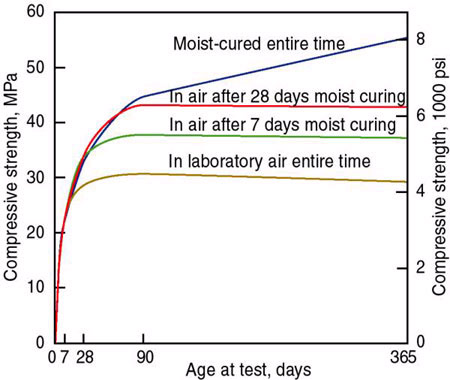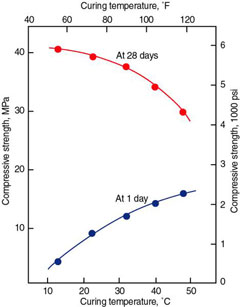Register now or log in to join your professional community.

Thank you ,,, and I wide like to answer according to the specefication of ( PCA ) American,s Cement Manufacturers and ( ACI ) American Concrete Institute and ( ASTM ) in order to get an exact information for all and also with more details than you want in your Q ,,So the Curing plays an important role on strength development and durability of concrete. Curing takes place immediately after concrete placing and finishing, and involves maintenance of desired moisture and temperature conditions, both at depth and near the surface, for extended periods of time. Properly cured concrete has an adequate amount of moisture for continued hydration and development of strength, volume stability, resistance to freezing and thawing, and abrasion and scaling resistance. The length of adequate curing time is dependent on the following factors:
Slabs on ground (e.g. pavements, sidewalks, parking lots, driveways, floors, canal linings) and structural concrete (e.g. bridge decks, piers, columns, beams, slabs, small footings, cast-in-place walls, retaining walls) require a minimum curing period of seven days for ambient temperatures above40 degrees Fahrenheit1.American Concrete Institute (ACI) Committee301 recommends a minimum curing period corresponding to concrete attaining70 percent of the specified compressive strength2. The often specified seven-day curing commonly corresponds to approximately70 percent of the specified compressive strengths. The70 percent strength level can be reached sooner when concrete cures at higher temperatures or when certain cement/admixture combinations are used. Similarly, longer time may be needed for different material combinations and/or lower curing temperatures. For this reason, ACI Committee308 recommends the following minimum curing periods3:
Effect of curing duration on compressive strength development is presented in Figure1.
 Figure1. Moist Curing Time and Compressive Strength Gain
Figure1. Moist Curing Time and Compressive Strength Gain
Higher curing temperatures promote an early strength gain in concrete but may decrease its28-day strength. Effect of curing temperature on compressive strength development is presented in Figure2.

Figure2. Effect of Curing Temperature on Compressive Strength
There are three main functions of curing: 1) Maintaining mixing water in concrete during the early hardening process
Ponding and immersion Ponding is typically used to cure flat surfaces on smaller jobs. Care should be taken to maintain curing water temperature at not more than20 degrees Fahrenheit cooler than the concrete to prevent cracking due to thermal stresses. Immersion is mainly used in the laboratory for curing concrete test specimens.Spraying and fogging Spraying and fogging are used when the ambient temperatures are well above freezing and the humidity is low. Fogging can minimize plastic shrinkage cracking until the concrete attains final set.Saturated wet coverings Wet coverings saturated with water should be used after concrete has hardened enough to prevent surface damage. They should be kept constantly wet. Left in Place Forms Left in place forms usually provide satisfactory protection against moisture loss for formed concrete surfaces. The forms are usually left in place as long as the construction schedule allows. If the forms are made of wood, they should be kept moist, especially during hot, dry weather.
2) Reducing the loss of mixing water from the surface of the concrete
Covering concrete with impervious paper or plastic sheets Impervious paper and plastic sheets can be applied on thoroughly wetted concrete. The concrete surface should be hard enough to prevent surface damage from placement activities. Applying membrane-forming curing compounds Membrane-forming curing compounds are used to retard or reduce evaporation of moisture from concrete. They can be clear or translucent and white pigmented. White-pigmented compounds are recommended for hot and sunny weather conditions to reflect solar radiation. Curing compounds should be applied immediately after final finishing. Curing compound shall comply with ASTM C3094 or ASTM C13155.
3) Accelerating strength gain using heat and additional moisture
Live steam Live steam at atmospheric pressure and high-pressure steam in autoclaves are the two methods of steam curing. Steam temperature for live steam at atmospheric pressure should be kept at about140 degrees Fahrenheit or less until the desired concrete strength is achieved.Heating coils Heating coils are usually used as embedded elements near the surface of concrete elements. Their purpose is to protect concrete from freezing during cold weather concreting. Electrical heated forms or pads Electrical heated forms or pads are primarily used by precast concrete producers.Concrete blankets Concrete insulation blankets are used to cover and insulate concrete surfaces subjected to freezing temperatures during the curing period. The concrete should be hard enough to prevent surface damage when covering with concrete blankets.
Other forms of curing include internal moist curing with lightweight aggregates or absorbent polymer particles. For mass concrete elements (usually thicker than3 feet), a thermal control plan is usually developed to help control thermal stresses. Additional information can be found in ACI Committee308 report Guide to Curing Concrete3. For specialty concretes, it is recommended to refer to other ACI reports as follows:
Curing in either cold or hot weather requires additional attention. In cold weather, some of the procedures include heated enclosures, evaporation reducers, curing compounds, and insulating blankets. The temperature of fresh concrete shall be above50 degrees Fahrenheit. The curing period for cold weather concrete is longer than the standard period due to reduced rate of strength gain. Compressive strength of concrete cured and maintained at50 degrees Fahrenheit is expected to gain strength half as quickly as concrete cured at73 degrees Fahrenheit. In hot weather, curing and protection are critical due to rapid moisture loss from fresh concrete. The curing actually starts before concrete is placed by wetting substrate surfaces with water. Sunscreens, windscreens, fogging, and evaporation retardants can be used for hot weather concrete placements. Since concrete strength gain in hot weather is faster, curing period may be reduced. Additional information can be found in ACI306.1, Standard Specification for Cold Weather Concreting, ACI306R, Cold Weather Concreting, ACI305.1, Specification for Hot Weather Concreting, and ACI305R, Hot Weather Concreting
Curing Concrete Test Specimens
Curing of concrete test specimens is usually different from concrete placed during construction. American Society for Testing and Materials (ASTM) has developed two standards for making and curing concrete specimens. ASTM C1926 is intended for laboratory samples while ASTM C317 is intended for field samples. Both documents provide standardized requirements for making, curing, protecting, and transporting concrete test specimens under field or laboratory conditions, respectively. ASTM C192 provides procedures for evaluation of different mixtures in laboratory conditions. It is usually used in the initial stage of the project, or for research purposes. ASTM C31 is used for acceptance testing and can also be used as a decision tool for form or shoring removal. Depending on its intended purpose, the standard defines two curing regimes: standard curing for acceptance testing and field curing for form/shoring removal. Variation in standard curing of test specimens can dramatically affect measured concrete properties. According to the National Ready Mix Concrete Association8 (NRMCA), strength for concrete air cured for one day followed by27 days moist cured will be approximately8 percent lower than for concrete moist cured for the entire period. The strength reduction is11 percent and18 percent for concrete specimens initially cured in air for three days and seven days, respectively. For the same air/moist curing combinations, but100 degrees Fahrenheit air curing temperature, the28-day strength will be approximately11 percent,22 percent, and26 percent lower, respectively.

Thank you Mr. Muhammad and all the colleagues who have enriched the subject by their answers, especially Mr. Fouad
Notes about the process of reinforced concrete curing
1-Should not start curing before the start of the cohesion and hardness of cement adequately
2-Must start curing as soon as confirmation of cohesion and hardening of cement
3 - Treatment continues for reinforced concrete, until its ability to carry pressure is being acceptable. In the case of curing by water and using hardening moderate Portland cement It is must to be between7-14 days depending on the temperature and humidity of air and less than the period when We use rapid hardening Portland cement and vice versa.hg.

14 days at most specification

4 hours after casting is good, if we're talking about normal conditions.
greetings to all other great answers :)

The duration of curing of concrete depends on the grade & type of cement, mix proportion, desired concrete strength, shape and size of the concrete member and environmental & exposure conditions. The duration may vary from few days to a month.IS-456:2000 provisions for duration of Curing (Indian Standard-Plain & Reinforced concrete-Code of Practice,4th revision, page27)Exposed surfaces of concrete shall be kept continuously damp or in a wet condition by ponding or by covering with sacks, canvas, hessian or other similar material and kept continuously wet for atleast7 days from the date of placing, in case of Ordinary Portland Cement (OPC) and atleast10 days when mineral admixtures or blended cements are used. In case of concrete where mineral admixtures or blended cements are used, it is recommended that the above minimum periods may be extended to14 days, for assisting the secondary reaction.

Must adopt following criteria for curing of RCC structural members
a) Beam-7 days curing
b) Column- 7 days curing
c) Slabs -2 to3.5 weeks

The duration may vary from few days to a month





Do you need help in adding the right keywords to your CV? Let our CV writing experts help you.